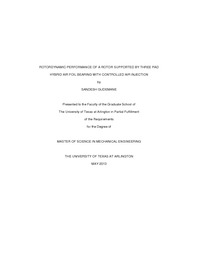
ATTENTION: The works hosted here are being migrated to a new repository that will consolidate resources, improve discoverability, and better show UTA's research impact on the global community. We will update authors as the migration progresses. Please see MavMatrix for more information.
Show simple item record
| dc.contributor.author | Gudemane, Sandesh | en_US |
| dc.date.accessioned | 2014-03-10T21:03:37Z | |
| dc.date.available | 2014-03-10T21:03:37Z | |
| dc.date.issued | 2014-03-10 | |
| dc.date.submitted | January 2013 | en_US |
| dc.identifier.other | DISS-12210 | en_US |
| dc.identifier.uri | http://hdl.handle.net/10106/24017 | |
| dc.description.abstract | Air Foil Bearings have found their place in the commercial applications of turbo machinery. They are cleaner and more reliable at high speeds than their conventional counterparts (Rolling Element Bearings). Low drag friction and apparently no contact during the operation results in a better service life and superior rotor-dynamic performance of the air foil bearings (AFBs). With these advantages AFB has proved to be a suitable option for oil-free turbo-machinery. Further development in AFBs suggest that pressurizing these bearings externally results in remarkably better load carrying capacity, heat dissipation and a more stable rotor. These externally air pressurized bearings which operate under hydrodynamic pressure with a hydrostatic lift are called Hybrid Air foil Bearing (HAFB). One of the major rotordynamic problem encountered in high speed turbomachinery is the subsynchronous vibration. If left unchecked, the higher amplitudes of subsynchronous vibrations can cause some serious damage to the bearing as well as the turbomachine. A previous study by Kim, D and Varrey, M [1] on a rotor of 4.84 kg supported by a three pad HAFB demonstrated the effects of increased air feed on the subsynchronous vibrations. The tests suggested an increase in the onset speed of subsynchronous vibration with higher pressures but minimal changes were observed in the natural frequencies. The present work is to numerically investigate the feasibility of controlled air injection to stabilize the rotor at high speeds. The intention is to push the rotor to higher eccentricity by loading it in one direction with the help of controlled air injection. The numerical analysis is carried out by orbit simulation method on a three pad HAFB of diameter 49 mm to test the whirl instability. The orbit simulation result suggests a delay in the appearance of subsynchronous vibrations. Further, experiments are carried out on a similar arrangement with the same rotor-bearing parameters. The shaft is loaded at the witness of subsynchronous vibrations (instability) to validate the simulation results. In actual practice out of the three air injection lines, one of the air injection lines is blocked to allow shaft loading and to notice its effects on the subsynchronous vibrations. The results were favorable, the amplitudes of subsynchronous vibrations diminished instantly suggesting a stable rotor as expected. | en_US |
| dc.description.sponsorship | Kim, Daejong | en_US |
| dc.language.iso | en | en_US |
| dc.publisher | Mechanical Engineering | en_US |
| dc.title | Rotordynamic Performance Of A Rotor Supported By Three Pad Hybird Foil Bearings With Controlled Air Injection | en_US |
| dc.type | M.S. | en_US |
| dc.contributor.committeeChair | Kim, Daejong | en_US |
| dc.degree.department | Mechanical Engineering | en_US |
| dc.degree.discipline | Mechanical Engineering | en_US |
| dc.degree.grantor | University of Texas at Arlington | en_US |
| dc.degree.level | masters | en_US |
| dc.degree.name | M.S. | en_US |
Files in this item
- Name:
- Gudemane_uta_2502M_12210.pdf
- Size:
- 1.574Mb
- Format:
- PDF
This item appears in the following Collection(s)
Show simple item record


